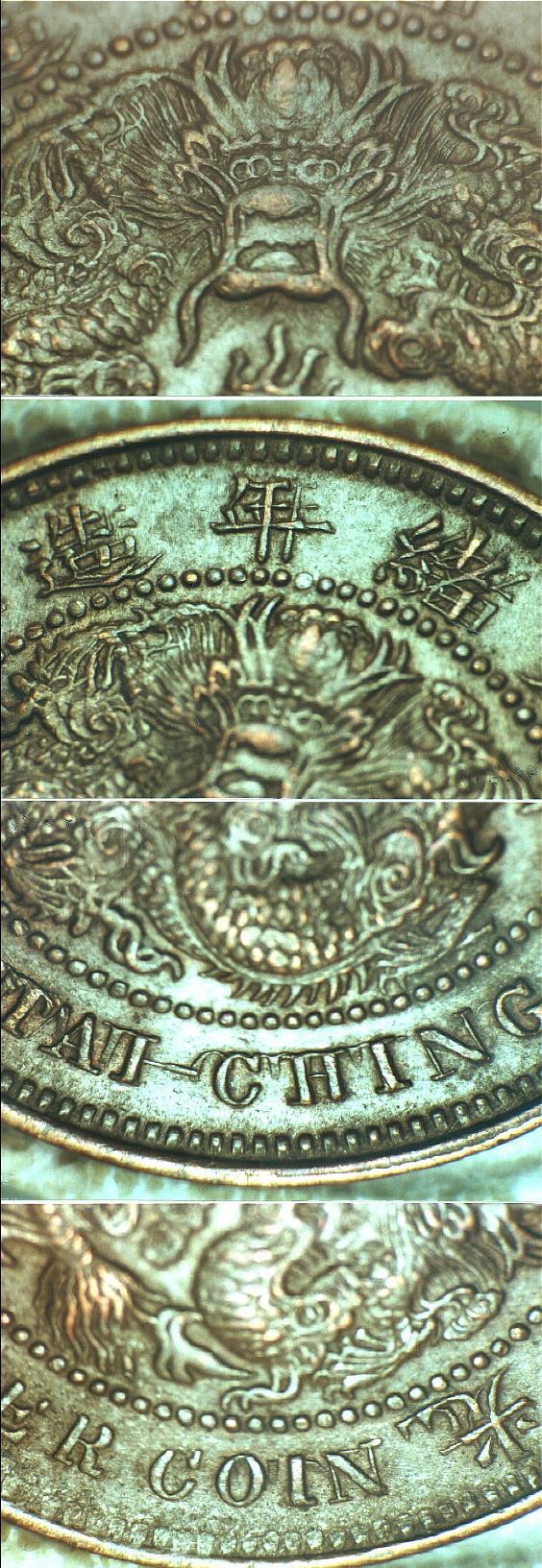
Selections from
The Variety Coin Register®
Chinese Cash Sports Four-eyed
Dragon
by Ken Potter
Copyright Ken Potter 1999, 2001
Excerpted from May 1999 World Coin News
Visiting Varieties Column
Minor editing changes made September 01, 2001

So far we’ve reported upon double tailed crocodiles, eagles with double feathers; beaks and claws, serpents with double rattlers; lions, cows, and an assortment of other animals with double bellies, legs, etc. Now, compliments of Ken Chylinski of St. Clair, Michigan, we have a four-eyed dragon to report!
Chylinski sent in a Chinese Kiangsu Province 1906 10 cash piece that boasts what is now the strongest doubled die listed in the Variety Coin Register for this country. The entire central design and many of the characters about the rim exhibit extremely strong hub doubling shifted in a counter clockwise direction. Virtually every individual design element of the dragon is strongly doubled making it appear to the naked eye as a blur. There is complete separation noted on most of the fine details including the horns and claws which display both hubbings (impressions) of near equal strength. Most doubled dies exhibit the earlier impressions in a significantly weaker state. This one is comparable to the US 1955 doubled die cent which also exhibits doubled images of near equal strength.
Interestingly, as strong and widespread as the doubling is, it ends abruptly with the word "CHING" and is completely absent from "TI — KUO COPPER CO". Widespread doubling then begins anew midway into the word "COIN". The abruptness of doubling is counter to that typical of rotated-hub or pivoted-hub doubled dies both of which are characterized by rotational spreads that either retain their strength on all elements about the rim or slowly taper to lesser spreads depending on the location of the pivot point. The characteristics on this coin seem suggestive of the use of two different hubs with variations in the position of the design on each. However, the tops of many of the letters of "COPPER" and the "CO" (of"COIN") exhibit "broken tops" due to hub breaks. If two different hubs were used this defect would have undoubtedly been "corrected" by the second hub which probably would not have shared the same identical defects. The entire circle of dots surrounding the central design are also devoid of any doubling which seems to defy "doubled die logic." The mystery of how the doubling on this coin was created could make an excellent research project for any specialist interested in this area and will undoubtedly unlock the secrets as to how the dies were made. Is was listed in The Variety Coin Register as VCR#1/DDO#1 in March of 1999.
If you enjoyed this feature you will also enjoy my monthly Visiting Varieties column! Click here: World Coin News to learn how to subscribe.
View 40+ pages of Error-Variety Coins,
U.S. Defaced Coinage Dies, Medals, Silver Art Bars/Rounds, Numismatic Books & Supplies
and an Educational Image Gallery by clicking below:
Ken Potter's Variety Vault

Or Go Directly To Each Updated Page by clicking below:
Books & Supplies
Error-Variety Coins
Rare-Coin-Reproductions
Defaced U.S. Coinage Dies
Book-Of-The-Month Special
Bars-Medals-Rounds & Other
Exonumia
Error/Variety Coin Examination Services
Ken Potter
P.O. Box 760232
Lathrup Village, MI 48076-0232
Phone: 1-(313)255-8907 E-mail: KPotter256@aol.com
I accept MasterCard & VISA payments
exclusively through X.com's PayPal!

Numismatist Since 1959 ~ Serving the
Collector Since 1973
CONECA's Longest Serving Doubled Die Attributer
Member of: ANA
CONECA-LM NLG NCADD-FM MSNS-LM
NWDCC RCC COINMASTERS LCS WBCC BBCC
Counter provided by Honesty.com.
Unless otherwise stated, all Photographic Images are
by Ken Potter. Copyright Ken Potter, 1993, 1994, 1995, 1996, 1997, 1998, 1999,
2000, 2001. Use of images in any manner is strictly prohibited without the express
written permission of the copyright holder.